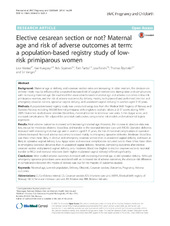| dc.description.abstract | Background Maternal age at delivery and cesarean section rates are increasing. In older women, the decision on delivery mode may be influenced by a reported increased risk of surgical interventions during labor and complications with increasing maternal age. We examined the association between maternal age and adverse outcomes in low-risk primiparous women, and the risk of adverse outcomes by delivery modes, both planned and performed (elective and emergency cesarean section, operative vaginal delivery, and unassisted vaginal delivery) in women aged ≥ 35 years. Methods A population-based registry study was conducted using data from the Medical Birth Registry of Norway and Statistics Norway including 169,583 low-risk primiparas with singleton, cephalic labors at ≥ 37 weeks during 1999 − 2009. Outcomes studied were obstetric blood loss, maternal transfer to intensive care units, 5-min Apgar score, and neonatal complications. We adjusted for potential confounders using relative risk models and multinomial logistic regression. Results Most adverse outcomes increased with increasing maternal age. However, the increase in absolute risks was low, except for moderate obstetric blood loss and transfer to the neonatal intensive care unit (NICU). Operative deliveries increased with increasing maternal age and in women aged ≥ 35 years, the risk of maternal complications in operative delivery increased. Neonatal adverse outcomes increased mainly in emergency operative deliveries. Moderate blood loss was three times more likely in elective and emergency cesarean section than in unassisted vaginal delivery, and twice as likely in operative vaginal delivery. Low Apgar score and neonatal complications occurred two to three times more often in emergency operative deliveries than in unassisted vaginal delivery. However, comparing outcomes after elective cesarean section and planned vaginal delivery, only moderate blood loss (higher in elective cesarean section), neonatal transfer to NICU and neonatal infections (both higher in planned vaginal delivery) differed significantly. Conclusions Most studied adverse outcomes increased with increasing maternal age, as did operative delivery. Although emergency operative procedures were associated with an increased risk of adverse outcomes, the absolute risk difference in complications between the modes of delivery was low for the majority of outcomes studied. | en_US |

